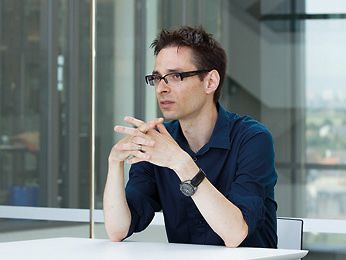Service Navigation
A conversation with Branimir Sesar – data detective
12 Jun 2018
A conversation with Branimir Sesar – data detective People & ideas at Deutsche Börse
Big data, smart data, artificial intelligence and machine learning are poised to change the way we think and the way we do business. Deutsche Börse is therefore actively focusing on data analysis in order to make effective use of the wealth of data at our fingertips, generating significant value in the process. To this end, Deutsche Börse’s Content Lab combines, processes and analyses internal and external data. Using pattern recognition and big data to create attractive new data products, the Content Lab is committed to playing a ground-breaking role in developing and deploying new technologies for the financial markets.
All this takes experts with knowledge you don’t necessarily find in the world of finance – so we had to look for talent from further afield. One of these experts is Branimir Sesar, an astronomer who studied our galaxy at the California Institute of Technology and the Max Planck Institute for Astronomy before joining Deutsche Börse’s Content Lab. What makes a “star man” join Deutsche Börse Group?
Branimir, could you first give us an overview of your background?
I was born in Zagreb, Croatia, and got my degree in physics there. During an astronomy project, I met a young Croatian researcher who worked at Princeton as a post-doctoral researcher. He liked the work I was doing which involved large amounts of astronomical data. He invited me to work with him. When he became professor at the University of Washington in Seattle, I moved there for graduate school. I graduated in astronomy, got my doctoral degree in 2010 and went to work at the California Institute of Technology as a post-doctoral scholar, again working with large data sets. In 2013, I got a job offer from Professor Hans-Walter Rix, one of the two directors at the Max Planck Institute for Astronomy in Heidelberg. The institute was a member of a large project in Astronomy, and he was looking for someone who could handle large data sets.
What was this project about?
The project I was involved in was called Pan-STARRS 1. They had a telescope in Hawaii that would take many pictures of the sky each night that would get converted into data tables. Those were used to look for stars that change their brightness, called variable stars. Some of the stars you see twinkling at night don’t really change brightness. Rather, the twinkling happens because of the earth’s atmosphere. But some stars really do change brightness over the period of a day. Some of them go through an entire cycle of changing from maximum brightness at midnight to quite dim ten hours later.
Why were you looking for these stars?
There are different kinds of variable stars. The ones I was interested in change their brightness by themselves. These particular stars expand and contract and their brightness changes. The way the brightness changes is very characteristic. Stars of the same type change their light in more or less the same way. They have a characteristic signature that one can find.
How exactly did you do that?
If the same region of the sky is observed many times, you can measure the brightness of each star and plot the changes in brightness over time. If you see the brightness change in a particular way then, you know it is a particular kind of star. That is essentially what I did: I looked for these stars by observing how their brightness changed.
And then? What do you do with this information?
One of the most difficult problems in astronomy is measuring the distance to a star. The problem is that we do not know the true brightness of each star because the star may be bright because it’s close or it could be bright because it’s naturally bright. So it’s very hard to figure out how far away or how naturally bright the star is. But for variable stars, we know from nuclear physics and astrophysics how bright they are. That means we can measure how far away they are.
What I was interested in was the structure of the Milky Way, our galaxy. Using variable stars, I was able to create a three-dimensional map of the galaxy to a very, very great distance, larger and with greater detail than anyone else before.
What made you switch from astronomy to finance?
Astronomy just wasn’t challenging enough anymore. I wanted to do something more challenging and more interesting where I could use a lot more data and learn different things. The world of finance seemed interesting because it affects all of us whether we want it to or not. The financial world creates lots of data and involves people, and I am interested in people. I am curious about how we can use the financial system to see how people would react to outside events.
The things that I found in astronomy may be of interest to someone in a thousand years, but I wanted to make an impact now. If I analyse financial data and find a way to make things more efficient, make predictions that help the company make money, you can point to it and say: here is an algorithm that predicts something and thanks to this prediction we have earned this much money or avoided such-and-such risk.
How did you end up joining Deutsche Börse’s Content Lab?
I started looking for opportunities in the financial sector and found an advertisement for a job here at Deutsche Börse’s Content Lab. Not knowing much about it, I read the job description and did what every data scientist would do: I tried to get more information. So I googled Content Lab and found Deutsche Börse’s corporate report featuring an article about Konrad Sippel, who is the head of the unit. I thought, “Wow! This is a great idea.” I liked that the Content Lab had the feel of a start-up within a large company. To cut it short, I applied, I got a very quick response, they were interested, I did the interviews and here I am.
The reason I want to stay here are the people. I like the people I work with. I also like that this work presents opportunities and challenges. Deutsche Börse produces a lot of data: that’s a great opportunity that the company should take advantage of. The challenge is how to efficiently use that data and convert it into something useful.
How can you put your specialist knowledge to use at the Content Lab?
In astronomy I used to search for stars whose light changed in a particular pattern. Now I am trying to predict events in markets by identifying patterns in financial data. For example, for one use case I created a programme that uses data from Clearstream and Eurex in order to predict how many settlement instructions are expected fail in the future . These predictions could be used by Clearstream to possibly prevent such failures in the future and ensure a smoother functioning of the settlement process. For another use case, I looked at settlement patterns of Clearstream customers and built a system that recommends securities that may be of interest to a customer, based on their behaviour as well as the behaviour of many other customers.
Let’s branch out a little: You have been involved in research and new technologies. Generally speaking, which invention has been the most important in your eyes?
I would say writing. It allowed us to store knowledge for future generations. Before that, people would tell stories. Good storytellers could tell good stories but even good storytellers die. Things get lost or changed, sometimes for the worse. Writing preserves knowledge for future generations. Computers allow us to store and process more of our knowledge, but in the end they are just an incremental improvement on writing. Writing is responsible for what we have today. Knowledge has always been the most valuable commodity on this planet.
Interview: Jürgen Pfeiffer


